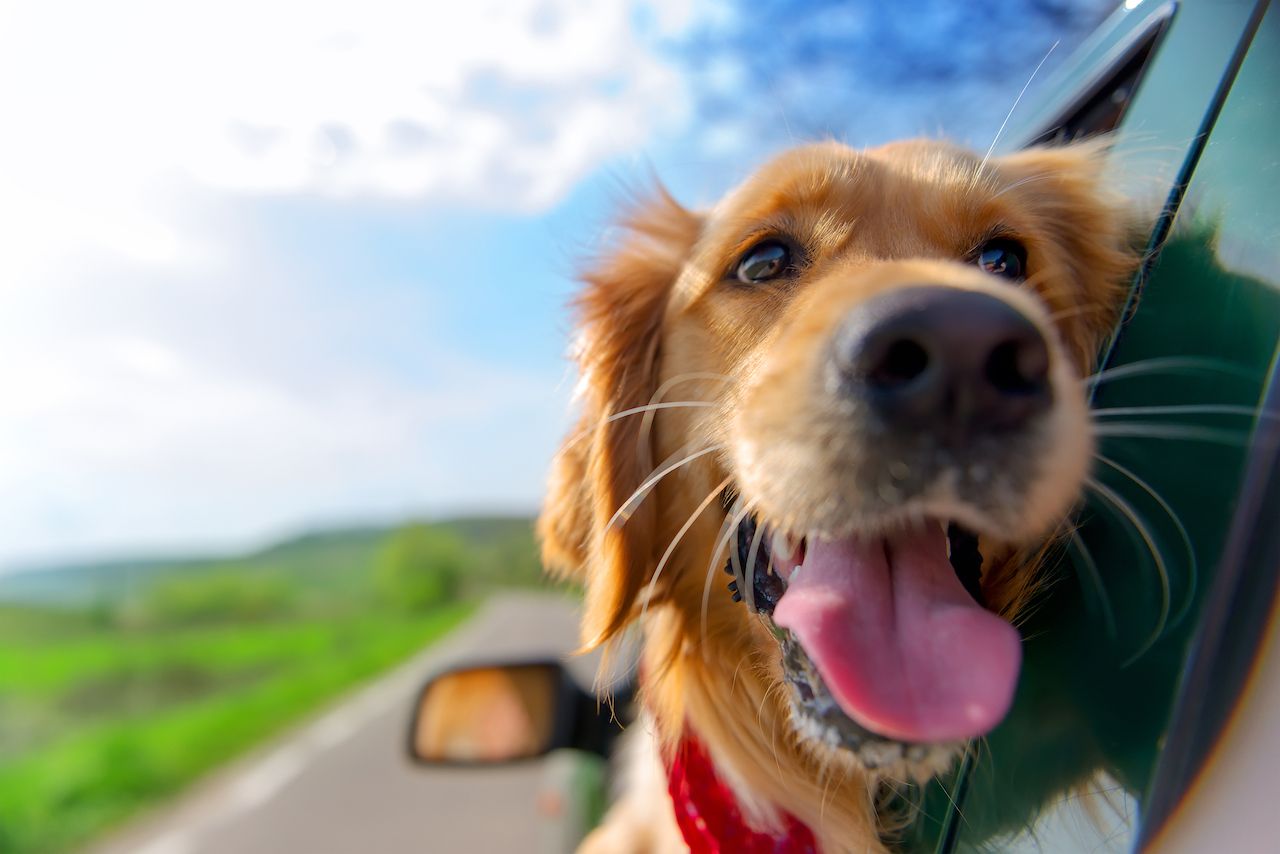Your ultimate road trip playlist is set, you’ve packed enough snacks for your journey, and Google Maps is loaded with the destination. Now it’s time to pack your dog, the perfect road trip companion. Your dog won’t skip your favorite song, be a backseat driver, and hopefully won’t hog all the beef jerky. If you’re heading out on the road with your pet, follow these simple tips to prime your dog for an adventure of a lifetime.


Dogs Are the Ultimate Road Trip Companion. Here’s How to Plan a Trip With Yours.
1. Consider how well your dog travels.
Before embarking on your latest adventure, take stock of your pet’s behavior in the car. Perhaps your dog is already accustomed to long car rides and remains comfortable and quiet the whole journey. However, if they’re nervous or get carsick when placed in a vehicle, it’s time for some training. If the only exposure your pet has to the car is a dreaded trip to the vet, they may associate the ride with negative experiences.
If they’re visibly nervous when in the car, start by taking short trips to exciting places. Begin by rewarding your dog with treats as you walk to the car. Next, take trips to favorite locations, such as the park or pet store. Continue to praise and hand out treats when driving, parked, and when you reach your destination. Then, slowly start to build up the time spent in the car so the association with rides switches from negative to positive.
Some dogs experience motion sickness the same way people do. This might show through excessive yawning, whining, or lip-smacking. If this is the case, PetMD suggests restricting food before traveling, trying over-the-counter medications, and letting your dog sit near the front. If problems persist, visit your vet to have them prescribe something stronger. If your dog really struggles with motion sickness or isn’t becoming more comfortable with the car, it’s worth considering whether to bring your dog at all.
2. Do your research on microchipping and pack documentation.
You wouldn’t travel without identification and essential vaccinations, so neither should your dog. If you’re crossing country borders, check for vaccination requirements. Many countries require proof of updated rabies vaccination, proof of flea treatment, a clean bill of health from your veterinarian, and other requirements depending on the region. For example, when crossing the border from the US into Canada, the USDA requires all dogs and puppies over eight months to provide proof of rabies vaccination.
It’s also important to note any breed specific legislation in the area you’re traveling to or through. This can hinder your travel if your dog is a breed, or looks like a breed, not allowed in certain towns. For example, if you’re traveling with a pit bull, Go Pet Friendly recommends planning routes that will avoid areas where your dog may not be allowed, and checking in with any accommodation that your pet’s breed is okay.
Additionally, it’s helpful for your dog to be comfortable with a brief inspection by strangers. Most border crossings don’t require one, but occasionally, like humans at airports, some enforce special screenings. Pack a muzzle if your pet struggles with being touched by strangers.
Finally, make sure you have a well-fitting collar or harness with updated identification and contact information in the event your pet gets loose. If you haven’t already, microchip your dog. A microchip is a permanently implanted chip that acts as a form of identification and should include your name, contact details, and your pet’s name. Many shelters and veterinarians have universal scanners for these microchips, which will make contacting you easy should your pet become lost.
3. Pack the necessary supplies.

Photo: Igor Normann/Shutterstock
Next, it’s time to pack supplies. A first aid kit is a great investment, or you can make your own. Modern Dog Magazine recommends essentials such as antihistamines, gauze, bandages, and paw balm. Research the hazards of your destination and areas you’ll be traveling through to be prepared for ailments that may arise. Some areas, such as forests and prairie lands of the US are prone to ticks that can be lethal to dogs. Be aware of these hazards prior to venturing into the area, know how to prevent them, and rectify them to keep safe on the road.
Be sure to bring essentials like a lead, bed, blankets for muddy paws, and a favorite toy. If your dog is easily bored, bring interactive toys like puzzles or chews.
4. Think about food.
Dogs can be finicky eaters, so pack enough food for your whole trip. Searching around for a brand your pet will eat while in an unfamiliar place can cause unnecessary stress for both you and your pet. Keep in mind the practicality of the food you feed your dog, as well. If the food needs to be refrigerated, invest in a cooler for the road trip or consider switching the diet to a freeze-dried version. Along with food, be sure to pack food and water dishes. Collapsible bowls take up less space and some even come with a clip to attach to your dog’s harness, perfect for long walks on hot days. And if your pet’s food is canned, remember to pack a can opener.
5. Restrain your dog.
Some dogs are more comfortable in their crates, especially if they have a crate at home. Others will find being crated the ultimate punishment and howl, cry, or vomit until you let them out into the unconfined space of your car. If you’re determined for crating to work, try crate training long before your trip and making a few trial runs. If you don’t crate restrain your dog, invest in a harness-seat belt combination that will limit them to one seat. Restraining is important, as without it your dog becomes a distraction or a flying projectile in an accident. The Bark offers great tips on how best to restrain dogs so everyone has a safe and comfortable car ride, from seat belts to dog hammocks.
6. Plan out frequent potty breaks.

Photo: LeventeGyori/Shutterstock
Depending on how long your journey is, plan out stops every two to three hours for quick walks and potty breaks. Look for stops with dog parks to let out some pent up energy. Roadside stops often offer long, grassy dog runs that can help stretch legs and provide a mental break from the stressors of a car. Often, the local dog park may just be a few minutes’ worth of a detour into the nearest town. This is a great chance to rehydrate too, so pack plenty of fresh water.
7. Treat your dog to daycare the day before.
A great way to tire out your dog the day before your trip is to treat them to a full day of doggy daycare. This allows you to fully engage with packing, prepping, and any last-minute organizing that needs to be done, all without an anxious dog in your way. Many pets become distressed when they see their owner packing things into a car, especially if they have anxiety about car rides. A day at daycare will allow them to tire out before the big adventure and for you to get what you need to get done.
Once you feel confident that you’ve packed the necessary supplies and your dog is comfortable in the car, you’re ready to roll.